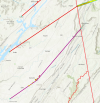Now that we have witnessed the extensive and staggering devastation caused by Hurricane Melissa, to be honest, for such an intense hurricane, the peak wind gusts in many coastal and mountainous areas were likely far beyond 215 mph, possibly much higher. Dropsondes even recorded a wind speed of 252 mph at an altitude of 250 meters. Considering the low sampling rate of dropsondes, the probability of capturing the absolute peak gust is negligible. In the cases of Michael and Dorian, some still argue that very few areas actually experienced wind gusts exceeding 200 mph. Now, with an even stronger hurricane making landfall at peak intensity (likely 165+ knots), and with 200m+ mountains located near the landfall site well within the boundary layer, I simply see no justification for continuing to debate whether these areas experienced EF5-level gusts.Hurricane Melissa currently has wind gusts exceeding 215 mph. Praying for everyone currently in the path. It's going to be devestating.
If it makes landfall at this strength who thinks the wind damage will resemble an EF5 tornado? Will entire forests be flattened and debarked? Cars and trains tossed? Ground scouring/trenching? There will certainly be a vertical wind component in the mountains too.
Yet, we did not observe EF5-level structural damage. In my opinion, the strongest destruction I’ve seen from this hurricane roughly falls within the high-end EF3 to low-end EF4 range, a result that was entirely expected. In reality, you’ll find that wind damage from 140-kt and 170-kt tropical cyclones is often difficult to distinguish in the field.
While hurricanes and tornadoes are fundamentally different, this once again highlights the shortcomings of relying solely on wind speed to gauge tornado intensity. From a vortex dynamics perspective, hurricanes generally have a very large swirl ratio, making it reasonable to apply the same wind speed standards uniformly.
However, in reality, some tornadoes can also have a very large swirl similar to hurricanes like Mulhall tornado 1999, while others can be extremely small like most rope type tornados. Additionally, tornadoes exhibit a much wider variability in diameter and translational speed compared to hurricanes, all of which add complexity to intensity assessment.
Currently, we cannot obtain precise wind speed measurements for every tornado. But if we could, we would quickly realize that relying purely on wind speed to determine intensity poses significant problems. In fact, mobile Doppler radar observations have already demonstrated this issue.
Last edited:



